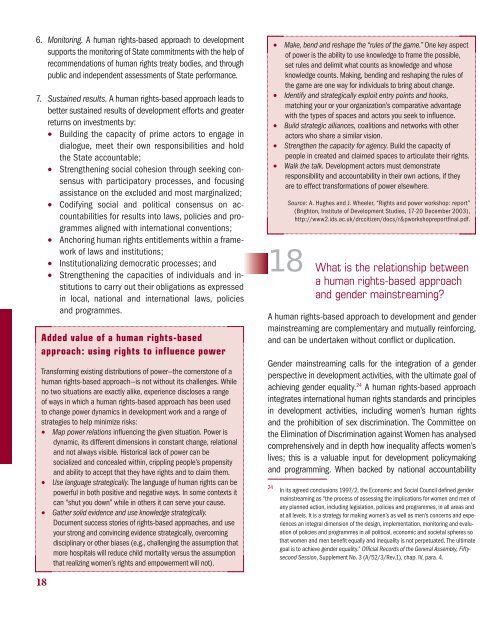Frequently Asked Questions on Human Rights-Based Approach
Frequently Asked Questions on Human Rights-Based Approach
Frequently Asked Questions on Human Rights-Based Approach
- No tags were found...
Create successful ePaper yourself
Turn your PDF publications into a flip-book with our unique Google optimized e-Paper software.
6. M<strong>on</strong>itoring. A human rights-based approach to developmentsupports the m<strong>on</strong>itoring of State commitments with the help ofrecommendati<strong>on</strong>s of human rights treaty bodies, and throughpublic and independent assessments of State performance.7. Sustained results. A human rights-based approach leads tobetter sustained results of development efforts and greaterreturns <strong>on</strong> investments by: Building the capacity of prime actors to engage indialogue, meet their own resp<strong>on</strong>sibilities and holdthe State accountable; Strengthening social cohesi<strong>on</strong> through seeking c<strong>on</strong>sensuswith participatory processes, and focusingassistance <strong>on</strong> the excluded and most marginalized; Codifying social and political c<strong>on</strong>sensus <strong>on</strong> accountabilitiesfor results into laws, policies and programmesaligned with internati<strong>on</strong>al c<strong>on</strong>venti<strong>on</strong>s; Anchoring human rights entitlements within a frameworkof laws and instituti<strong>on</strong>s;Instituti<strong>on</strong>alizing democratic processes; andStrengthening the capacities of individuals and instituti<strong>on</strong>sto carry out their obligati<strong>on</strong>s as expressedin local, nati<strong>on</strong>al and internati<strong>on</strong>al laws, policiesand programmes.Added value of a human rights-basedapproach: using rights to influence powerTransforming existing distributi<strong>on</strong>s of power—the cornerst<strong>on</strong>e of ahuman rights-based approach—is not without its challenges. Whileno two situati<strong>on</strong>s are exactly alike, experience discloses a rangeof ways in which a human rights-based approach has been usedto change power dynamics in development work and a range ofstrategies to help minimize risks: Map power relati<strong>on</strong>s influencing the given situati<strong>on</strong>. Power isdynamic, its different dimensi<strong>on</strong>s in c<strong>on</strong>stant change, relati<strong>on</strong>aland not always visible. Historical lack of power can besocialized and c<strong>on</strong>cealed within, crippling people’s propensityand ability to accept that they have rights and to claim them. Use language strategically. The language of human rights can bepowerful in both positive and negative ways. In some c<strong>on</strong>texts itcan “shut you down” while in others it can serve your cause. Gather solid evidence and use knowledge strategically.Document success stories of rights-based approaches, and useyour str<strong>on</strong>g and c<strong>on</strong>vincing evidence strategically, overcomingdisciplinary or other biases (e.g., challenging the assumpti<strong>on</strong> thatmore hospitals will reduce child mortality versus the assumpti<strong>on</strong>that realizing women’s rights and empowerment will not).18 What is the relati<strong>on</strong>ship betweena human rights-based approachand gender mainstreaming?A human rights-based approach to development and gendermainstreaming are complementary and mutually reinforcing,and can be undertaken without c<strong>on</strong>flict or duplicati<strong>on</strong>.Gender mainstreaming calls for the integrati<strong>on</strong> of a genderperspective in development activities, with the ultimate goal ofachieving gender equality. 24 A human rights-based approachintegrates internati<strong>on</strong>al human rights standards and principlesin development activities, including women’s human rightsand the prohibiti<strong>on</strong> of sex discriminati<strong>on</strong>. The Committee <strong>on</strong>the Eliminati<strong>on</strong> of Discriminati<strong>on</strong> against Women has analysedcomprehensively and in depth how inequality affects women’slives; this is a valuable input for development policymakingand programming. When backed by nati<strong>on</strong>al accountability24Make, bend and reshape the “rules of the game.” One key aspectof power is the ability to use knowledge to frame the possible,set rules and delimit what counts as knowledge and whoseknowledge counts. Making, bending and reshaping the rules ofthe game are <strong>on</strong>e way for individuals to bring about change.Identify and strategically exploit entry points and hooks,matching your or your organizati<strong>on</strong>’s comparative advantagewith the types of spaces and actors you seek to influence.Build strategic alliances, coaliti<strong>on</strong>s and networks with otheractors who share a similar visi<strong>on</strong>.Strengthen the capacity for agency. Build the capacity ofpeople in created and claimed spaces to articulate their rights.Walk the talk. Development actors must dem<strong>on</strong>strateresp<strong>on</strong>sibility and accountability in their own acti<strong>on</strong>s, if theyare to effect transformati<strong>on</strong>s of power elsewhere.Source: A. Hughes and J. Wheeler, “<strong>Rights</strong> and power workshop: report”(Bright<strong>on</strong>, Institute of Development Studies, 17-20 December 2003),http://www2.ids.ac.uk/drccitizen/docs/r&pworkshopreportfinal.pdf.In its agreed c<strong>on</strong>clusi<strong>on</strong>s 1997/2, the Ec<strong>on</strong>omic and Social Council defined gendermainstreaming as “the process of assessing the implicati<strong>on</strong>s for women and men ofany planned acti<strong>on</strong>, including legislati<strong>on</strong>, policies and programmes, in all areas andat all levels. It is a strategy for making women’s as well as men’s c<strong>on</strong>cerns and experiencesan integral dimensi<strong>on</strong> of the design, implementati<strong>on</strong>, m<strong>on</strong>itoring and evaluati<strong>on</strong>of policies and programmes in all political, ec<strong>on</strong>omic and societal spheres sothat women and men benefit equally and inequality is not perpetuated. The ultimategoal is to achieve gender equality.” Official Records of the General Assembly, Fiftysec<strong>on</strong>dSessi<strong>on</strong>, Supplement No. 3 (A/52/3/Rev.1), chap. IV, para. 4.18
















